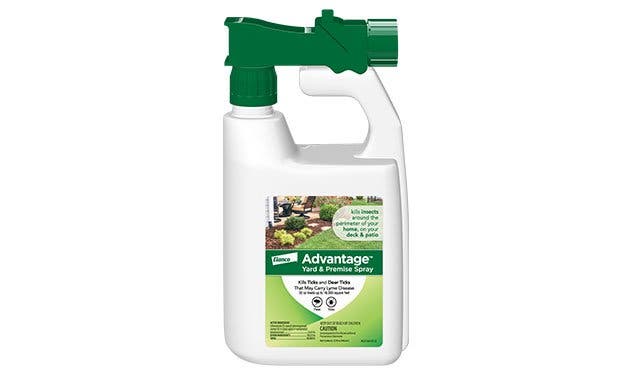Your yard is more than your sanctuary or your pet’s favorite territory; it may also be a prime location for fleas and ticks. Learn about effective yard treatments for fleas and ticks, as well as other steps you can take to stop an infestation.
Flea and tick infestations can start when stray pets and wildlife — like raccoons, opossums or foxes — bring these parasites into your yard. Flea eggs and ticks fall off a visiting animal, leaving them in your yard for you or your pet to pick up.
As much as we’d like to think fleas and ticks will remain outside, their presence in your yard brings them that much closer to invading your home and your pet.
So, how can you manage your environment and help get rid of fleas and ticks in your yard? Follow these five steps to treat your pet and your yard.
Step 1: Treat Your Pet
Fleas and ticks feed on your pet and may use them to hitch a ride into your home. To minimize the risk of further yard and home infestation, include treating your pet as part of the solution.
Chewables, tablets, shampoos and spray treatments allow you to combat existing fleas on your pet. Once you have treated an infestation, maintain protection with a regular application of topical, collar or oral flea and tick preventive.
Step 2: Prepare Your Lawn
Long grass and overgrown foliage protect fleas from sunlight and provide ticks with a place to climb, so be sure to keep them trimmed. Shorter grass and foliage help decrease moisture and can allow chemical applications to reach the fleas and ticks more easily.
To make your yard less hospitable to fleas and ticks, take the following steps:
- Mow your lawn.
- Prune foliage regularly.
- Clean up clippings and yard waste.
Step 3: Keep Your Yard Tidy
Fleas thrive in shady, humid spots and typically avoid sunny or dry areas. Rid your yard of these potential flea and tick hiding spots:
- Discard empty bird or rodent nests.
- Remove stacks of bricks, logs or unused garden pots.
- Pick up pets’ and children’s toys.
Step 4: Treat Your Yard
Choose a premise spray labeled to kill adult fleas and ticks. Spray along fence lines, under trees and bushes, and around doorframes. Be sure to treat areas with lots of shade, such as:
- Dog houses or kennels
- Sheds, patios and crawl spaces
- Shrubbery up to a height of 2 to 3 feet
Continue to treat your yard and home exterior according to label directions.
Step 5: Minimize Wildlife Visitors
Stray or neighboring wildlife such as squirrels, deer, rabbits, raccoons and mice can easily transport fleas or ticks to your yard. Make your property less desirable to these animals and limit their access by following these tips:
- Patch up holes in fences.
- Keep a lid on garbage cans.
- Clean up birdseed.
- Remove uneaten pet food.
- Install deer fencing.
- Plant deer-resistant plants.
Reclaim Your Territory
Just because fleas and ticks are part of nature doesn’t mean they should be part of your yard. Enjoy more moments outside with your pet all year long by taking care to protect your yard from these parasites.

Advantage® Yard & Premise Spray
Kills fleas, ticks and other insects in your yard and around the perimeter of your home. Not for use on pets. Use as directed.

Advantage® XD (spinetoram)
Kills fleas for two months with one dose, outlasting the typical six-week flea life cycle — and the monthly competition.

Seresto® Flea & Tick Collar for Dogs
An easy-to-use, odorless, non-greasy collar that kills and repels fleas and ticks for 8 continuous months.




